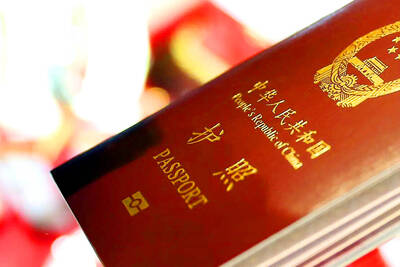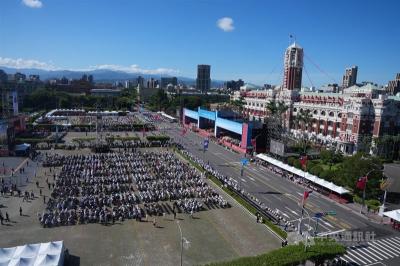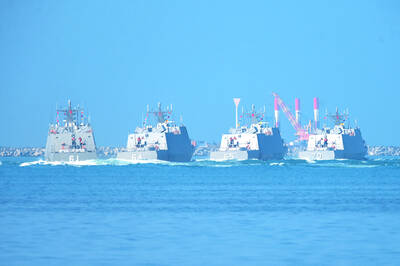The issue of whether the Tongyong Pinyin (通用拼音) system or China's Hanyu Pinyin (漢語拼音) system should be used as the standard method of Romanizing Mandarin will go to the Executive Yuan for review, the Minister of Education said yesterday.
The ministry's Mandarin Promotion Council decided to support the Tongyong system last Saturday, sparking fierce controversy.
Minister of Education Ovid Tzeng (曾志朗) said yesterday that as an administrator he would respect the council's stance, but he planned to present both systems to the Executive branch for evaluation.
As a linguist, Tzeng said, he favors the Hanyu Pinyin system that is the standard in China and other Mandarin-speaking countries, such as Singapore.
Tzeng noted that Hanyu Pinyin is a universal system. "It [Hanyu Pinyin] still exists no matter whether we [Taiwan] recognize it or not," he said. "The real issue is how we want to make use of the system. Will the system we choose be used only in Taiwan, or will the system help us keep abreast with the global trend?"
Tzeng added that his opinions were made out of his professional knowledge as a linguist, and no political or ideological considerations were involved.
He also said that for those who support the Tongyong Pinyin system, they should provide grounds to demonstrate how it would facilitate the teaching and learning of local languages at schools.
"This is a matter of great significance. The decision deserves thorough discussion with more specialists and administrators. We should not jump to any hasty conclusions," the education minister said.
Responding to Tzeng's remarks, Lin Cheng-hsiou (林正修), director of the Taipei City Government's Bureau of Civil Affairs and who favors using Hanyu Pinyin, thought highly of Tzeng's views that Hanyu Pinyin was a globally used system and said that the issue required further consideration.
"Taipei City is the region with the most foreign residents in Taiwan, therefore the opinion of the city government needs to be taken into account," Lin said.
Taipei Mayor Ma Ying-jeou (
Ma said debate has never stopped surrounding the inconsistency of the Romanization system used in Taiwan.
"Now that the authorities have decided to adopt a system that has long been criticized by foreigners, it means that Taipei can not keep up with global trends and as a result will never become an international city," he said.
"Besides, given the several discussions over the issue with Tzeng in the past, I have had the perception that Tzeng is not in accord with the view of other representatives at the education ministry."
"The Taipei City Government has no prejudice over any system and I think politics should not play a part in the matter. All we [city officials] want to achieve is the goal of globalization," Ma said.
The mayor said that he would seek to communicate with Tzeng in the near future to ease the tension caused by the disparate views of different administrative agencies.
Inconsistencies in the Romanization system used in Taiwan have long been debated.
Foreign visitors often complain that discrepancies in street signs have made it hard to get around in the country.
Hanyu Pinyin was invented in China and was accepted by the UN in 1986 as a standardized Mandarin Romanization system, whereas the Tongyong Pinyin system was designed by Yu Po-chuan (余伯泉), a researcher at Academia Sinica, in accordance with international phonetics and the Taiwanese method for Romanizing Chinese.
The main difference between the two systems is that the Tong-yong system uses a lot of local words and languages.
This, say some experts, can cause even more confusion for foreigners.

The Ministry of the Interior (MOI) is to tighten rules for candidates running for public office, requiring them to declare that they do not hold a Chinese household registration or passport, and that they possess no other foreign citizenship. The requirement was set out in a draft amendment to the Enforcement Rules of the Public Officials Election and Recall Act (公職人員選舉罷免法 ) released by the ministry on Thursday. Under the proposal, candidates would need to make the declaration when submitting their registration forms, which would be published in the official election bulletin. The move follows the removal of several elected officials who were

The Republic of China (ROC) is celebrating its 114th Double Ten National Day today, featuring military parades and a variety of performances and speeches in front of the Presidential Office in Taipei. The Taiwan Taiko Association opened the celebrations with a 100-drummer performance, including young percussionists. As per tradition, an air force Mirage 2000 fighter jet flew over the Presidential Office as a part of the performance. The Honor Guards of the ROC and its marching band also heralded in a military parade. Students from Taichung's Shin Min High School then followed with a colorful performance using floral imagery to represent Taiwan's alternate name

FOUR DESIGNATED AREAS: Notices were issued for live-fire exercises in waters south and northwest of Penghu, northeast of Keelung and west of Kaohsiung, they said The military is planning three major annual exercises across the army, navy and air force this month, with the navy’s “Hai Chiang” (海強, “Sea Strong”) drills running from today through Thursday, the Ministry of National Defense said yesterday. The Hai Chiang exercise, which is to take place in waters surrounding Taiwan, would feature P-3C Orion maritime patrol aircraft and S-70C anti-submarine helicopters, the ministry said, adding that the drills aim to bolster the nation’s offshore defensive capabilities. China has intensified military and psychological pressure against Taiwan, repeatedly sending warplanes and vessels into areas near the nation’s air defense identification zone and across

A Chinese takeover of Taiwan would severely threaten the national security of the US, Japan, the Philippines and other nations, while global economic losses could reach US$10 trillion, National Security Council Deputy Secretary-General Lin Fei-fan (林飛帆) wrote in an article published yesterday in Foreign Affairs. “The future of Taiwan is not merely a regional concern; it is a test of whether the international order can withstand the pressure of authoritarian expansionism,” Lin wrote in the article titled “Taiwan’s Plan for Peace Through Strength — How Investments in Resilience Can Deter Beijing.” Chinese President Xi Jinping’s (習近平) intent to take Taiwan by force